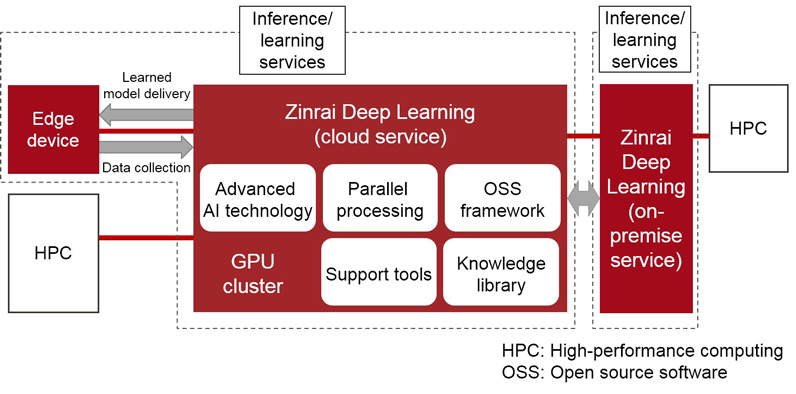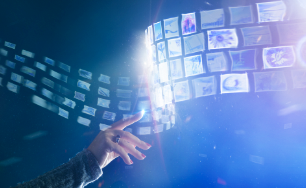Tech Topic
Zinrai Deep Learning for Business Innovation Through AI: Fundamentals and Case ExamplesJanuary 23, 2019
The global market for AI, which includes deep learning (hereafter, DL) and machine learning, is expected to see rapid growth in the coming years, and the market size is forecast to jump from 1.4 billion dollars in 2017 to 8.8 billion dollars in 2022. To enable customer businesses to deploy AI, Fujitsu launched FUJITSU Human Centric AI Zinrai in November 2015. Then, in November 2016, Fujitsu launched FUJITSU AI Solution Zinrai Deep Learning for using DL functions.
Here, we present an overview of the Zinrai Deep Learning Platform and an example application of DL in the monitoring security field. We also explain Fujitsu's technical services that use DL to help resolve customer-specific issues.
Overview of Zinrai Deep Learning Platform
The DL development process is divided into a learning phase and an inference phase. This DL development process can be accomplished efficiently through the Zinrai Deep Learning Platform, which is provided within the Zinrai Platform Service shown in the figure below. This platform provides cloud services that include the functions needed for the DL learning and inference processes, on-premise devices enabling deployment of the same software environment as the cloud services to the customer environment, and edge devices enabling linkage with cloud services. The features of this platform are as follows.
- Provides world’s best learning processing performance by using graphics processing unit (GPU) "NVIDIA Tesla P100" and Fujitsu proprietary parallel processing technology developed with the use of supercomputers
- Provides learned model delivery and relearning functions for edge devices
- Provides a verified, built, and ready-to-use development environment for all the hardware and software

Zinrai Deep Learning Platform
Using this platform, DL can be imported into some existing operation applications, and DL can be deployed in the work processes of on-site experienced technicians. However, because the data handled on-site has a wide range of features, we have received numerous requests for technical support in selecting the type of specific neural network that should be designed to conduct learning, and for guidance in how DL should be incorporated into existing business.
The Zinrai Deep Learning Technical Service receives customer data and performs the series of processes from the DL proof of concept (PoC) to build and operate learning models. In the verification phase, which is the first step of this technical service, Fujitsu provides service implementation support by assisting in demonstration and verification using the customer's data, and if necessary, also provides design support for the applications and systems using DL. After the verification results of the effects are confirmed with the customer, the system is introduced to the business, and a learning model is built. Then, after operation start, periodic updates of the learning model and other maintenance are performed.
DL has a wide applicable range and can handle many different data formats, including images, audio, text, chronological data, graph data, and more. The requirements for introducing DL are as follows.
- A large volume of data can be provided for both learning and evaluation (for example, in classification problems, a large volume of data up to a certain size is required for each classification class).
- Correct training data corresponding to each data set must be prepared.
- A principle correlation exists between the data and training data, and feature values can be correctly extracted.
- The purpose for applying DL to business is clearly defined, and an index, such as an accuracy rate or detection rate, can be established for setting a target.
The data analysis conducted initially at the PoC stage and the creation of the training data are particularly important. If the recognition accuracy does not reach the target, the data is revised by repeating the data cleansing process.
We will present an application example of using DL for a monitoring and safety business in the field of monitoring security. Currently, to assess traffic conditions and prevent crimes, there is a demand for car model classification technology based on images captured by security cameras without using expensive special-purpose equipment. For that reason, images from security cameras on streets were used to build a learning model that classifies car models. The target car models were the AQUA, FIT, and PRIUS, and the accuracy rate was assessed for 650 data images captured by a security camera. As shown in the table below, the platform was able to successfully classify the three target car models with an accuracy of more than 90%.
Accuracy rate for classifying car models

Technical Services for Deploying Training Data Creation Technology
In this type of car model classification, in order to use security camera images and identify which target image matches which car model, a large volume of training data containing the corresponding car model information must be prepared beforehand. Classifying specific car models and creating training data from the large number of images capturing various car types would require a tremendous amount of manual labor and entail a large cost.
In this way, Fujitsu provides technical services for assisting each individual customer in resolving their unique challenges. In the creation of this learning model, Fujitsu's technical services used computer graphics (CG) to introduce the training data creation technology. This technology was used to prepare a CG model of the target car models and to automatically generate a large volume of training data. This eliminated the need for manual classification. As a result, the time required for tagging in the learning process, which would have required 15 days if conventional images were used, was dramatically reduced to only 4 hours.
The innovative point in creating the training data for car model classification was the reproducibility of car colors and materials (design, metallic luster, roughness, etc.). As the CG image quality approaches that of an actual captured image, a high accuracy rate can be achieved as described above. CG modeling can be used not only for cars, but also for scenes of urban districts that include buildings for creating training data for a wide variety of objects, such as passers-by and signs, and scenes were even able to be created for events which actually occur with low frequency, such as accidents. This technology can be used to automatically generate large amounts of training data and video images with a high degree of freedom.
Going forward, we are aiming to expand Zinrai Deep Leaning Platform globally and to further develop solutions that can flexibly meet the diverse needs of customers for using AI.



